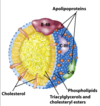Regulation Flashcards
Adipose hormones (Adipokines) act as sensors
Describe the role of Adiponectin
- Affects metabolism of faIy acids and carbohydrates
- ↑ rate of FA β-oxidation in muscle
- ↓ FA synthesis and gluconeogenesis in liver
- ↑ glucose uptake in muscle
- ↑ insulin sensitivity
- Effects of adiponectin are indirect as adiponectin acts through AMP dependent kinase (AMPK)
- AMPK is a fuel sensor regulating metabolic activity
Absense of adiponectin causes desensitization to what?
Insulin
Poor glucose tolerance; ingestion of dietary carbohydrates results in long-lasting rise in blood glucose, similar to type 2 diabetes.
Compare and contrast Leptin and Adiponectin
- Leptin
- Controled at the level of CNS
- Regulation of food intake and appetite
- Levels are higher in obesity
- Leptin resistance prevents anti-obesity effects
- Adiponectin
- Acts through tissue metabolism
- (less so through CNS)
- Levels are lower in obesity
- Hypoadiponectinemia + type 2 diabetes.
- Acts through tissue metabolism
Ghrelin
- Produced when hungry and about to eat a meal
- Peptide hormone produced in cells lining the stomach
- Acts on hypothalamus
- Stimulates appetite via plasma
- Levels peak just before a meal and drops after a meal
- Exceptionally high levels in Prader-Willi syndrome
PYY
- Peptide hormone produced by endocrine cells in the lining of the small intestines.
- Acts on hypothalamus to signal satiety
- Appetite suppresant, plasma levels peak after a meal
Orexigenic vs Anorexigenic neurons
Leptin acts on anorexigenic cells to release α-MSH, upregulating satiety and metabolism.
Leptin also acts on orexigenic cells to inhibit NPY, which is the “eat more” signal.
Ghrelin stimulates NPY.
PYY inhibits NPY.

What are the 2 mechanisms for degrading proteins?
Lysosomal degradation
- Nonselective
- material taken up by endocytosis
- intracellular constitutents enclosed in vesicles
- Highly selective
- Chaperone-mediated autophagy
Proteasome degradation
- Ubiquitination
Chapernone-mediated autophagy (CMA)
Critical during times of starvation in the liver and kidney.
Proteins are selected for degradation based on the KFERQ protein sequence. This sequence is exposed during gradual unfolding and turnover. 30% of liver and kidney proteins have this sequence.
What is Lamp2a?
Cytosolic chaperone protein recognizes KFERQ proteins and targets them to LAMP-2A at surface of lysosomes.
- LAMP-2A monomers aggregate to form multimeric complexes
- Protein is moved into the lysosome through the LAMP-2A complex (with assistance from lysosomal chaperone)
- LAMP-2A levels control CMA activity:
- Upregulation of Lamp-2A increases CMA Downregulation of Lamp-2A decreases CMA
Proteasome degradation
- Housekeeping
- Eliminates misfolded or damaged proteins
- Regulatory
- rapid system of degradation for proteins involved in regulatory function, like during the cell cycle
- A protein tagged with a chain of at least 4 ubiquitin molecules binds the 19S cap

The 1st step in the catabolism of most AAs in the liver

2nd step in the catabolism of most AAs in the liver
Oxidative deamination catalyzed by glutamate dehydrogenase

What is transdeamination?
Steps 1 and 2 of Amino Acid catabolism
Two nitrogen groups enter the urea cycle.
How do they do so?
1 enters as carbamoyl phosphate
1 enters as aspartate
*Liver mitochondria

Enzyme that forms Carbamoyl Phosphate
Carbamoyl phosphate synthetase:
couples HCO3 with NH4 to form carbamoyl phosphate

Where does the Urea Cycle take place?
- Mitochondrial
- Glutamate dehydrogenase
- Aspartate aminotransferase
- Carbamoyl phosphate synthetase
- 1 st step of Urea cycle
- Cytosolic
- Aminotransferases

What happens to NH4 from AA breakdown in extrahepatic tissue where there is no urea cycle?
Extrahepatic tissue transports NH4 through the bloodstream in the form of Glutamine. Once in the liver, NH4+ is removed from glutamine and is processed in the urea cycle.
- Glutamine Synthetase extrahepatically.
- followed by Glutaminase in the liver.
For muscle, Glucose-alanine cycle.
How is the Urea Cycle regulated?
-
Long-term regulation
- upregulation of urea cycle enzymes
- prolonged starvation
- high protein diets
- upregulation of urea cycle enzymes
-
Short-term regulation
- Allosteric activation of carbamoyl phsophate synthetase by N-acetylglutamate (a glutamate derivative whose concentration is proportional to glutamate).
Glucose-alanine cylce
- Amino groups are transferred to alanine.
- Alanine transports amino groups to liver for the urea cycle.
- Carbon skeleton is used for gluconeogenesis.
- Glucose is essentially forming pyruvate, which picks up the nitrogen via transamination.

Ketogenic vs. Glucogenic amino acids
Glucogenic AA’s can all result in net synthesis of glucose:
- Pyruvate
- α-ketoglutarate
- Succinyl-CoA
- Fumarate
- Oxaloacetate
Ketogenic AA’s → acetyl CoA ⇒ ketone bodies or Fatty Acids.
Formyl tratrahydrofolate
derived from Folic Acid, important donor of single carbons in biological systems.
De novo synthesis of purines
Production of IMP

Ribose Pentose Phosphate Pathway makes PRPP, which is the precursor of IMP (Inosine monophosphate).
PRPP makes purines and pyramidines, and some amino acids.
First committed step to purine synthesis is glutamine-PRPP aminotransferase, to make Phosphoribosylamine.
Amino acid synthesis
carbon-skeleton precursors
Glycolysis, CAC, and PPP

In amino acid synthesis,
Where are amino groups derived from?
Glutamate and Glutamine

















































